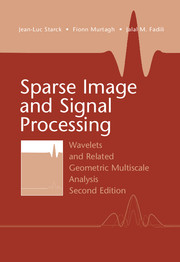Book contents
- Frontmatter
- Contents
- List of Acronyms
- Notation
- Foreword
- 1 Introduction to the World of Sparsity
- 2 The Wavelet Transform
- 3 Redundant Wavelet Transform
- 4 Nonlinear Multiscale Transforms
- 5 Multiscale Geometric Transforms
- 6 Sparsity andNoiseRemoval
- 7 Linear Inverse Problems
- 8 Morphological Diversity
- 9 Sparse Blind Source Separation
- 10 Dictionary Learning
- 11 Three-Dimensional Sparse Representations
- 12 Multiscale Geometric Analysis on the Sphere
- 13 Compressed Sensing
- 14 This Book's Take-Home Message
- Notes
- References
- Index
- Plate section
4 - Nonlinear Multiscale Transforms
Published online by Cambridge University Press: 05 October 2015
- Frontmatter
- Contents
- List of Acronyms
- Notation
- Foreword
- 1 Introduction to the World of Sparsity
- 2 The Wavelet Transform
- 3 Redundant Wavelet Transform
- 4 Nonlinear Multiscale Transforms
- 5 Multiscale Geometric Transforms
- 6 Sparsity andNoiseRemoval
- 7 Linear Inverse Problems
- 8 Morphological Diversity
- 9 Sparse Blind Source Separation
- 10 Dictionary Learning
- 11 Three-Dimensional Sparse Representations
- 12 Multiscale Geometric Analysis on the Sphere
- 13 Compressed Sensing
- 14 This Book's Take-Home Message
- Notes
- References
- Index
- Plate section
Summary
INTRODUCTION
Some problems related to the wavelet transform may impact on their use in certain applications. This motivates the development of other multiscale representations. Such problems include the following:
Negative values: By definition, the wavelet mean is zero. Every time we have a positive structure at a scale, we have negative values surrounding it. These negative values often create artifacts during the restoration process, or complicate the analysis.
Point artifacts: For example, cosmic ray hits in optical astronomy can “pollute” all the scales of the wavelet transform, because their pixel values are huge compared to other pixel values related to the signal of interest. The wavelet transform is non-robust relative to such real or detector faults.
Integer values:The discrete wavelet transform (DWT) produces floating values which are not easy to handle for lossless image compression.
Section 4.2 introduces the decimated nonlinear multiscale transform, in particular using the lifting scheme approach, which generalizes the standard filter bank decomposition. Using the lifting scheme, nonlinearity can be introduced in a straightforward way, allowing us to perform an integer wavelet transform, or a wavelet transform on an irregularly sampled grid. In Section 4.3 multiscale transforms based on mathematical morphology are explored. Section 4.4 presents the median-based multiscale representations which handle outliers well in the data (non-Gaussian noise, pixels with high intensity values, etc.).
DECIMATED NONLINEAR TRANSFORM
4.2.1 Integer Wavelet Transform
When the input data consist of integer values, the (bi-)orthogonal wavelet transform is not necessarily integer-valued. For lossless coding and compression, it is useful to have a wavelet transform which maps integer values to integers. We can build an integer version of every wavelet transform (Calderbank et al. 1998).
Information
- Type
- Chapter
- Information
- Sparse Image and Signal ProcessingWavelets and Related Geometric Multiscale Analysis, pp. 80 - 93Publisher: Cambridge University PressPrint publication year: 2015
